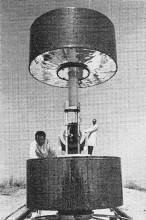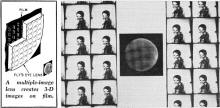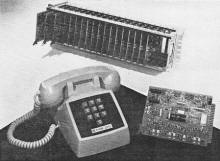News Briefs
|
|
When I hear the name Van de Graaff and think of the Jacob's Ladder gadget a lot of us built in junior high school, it seems like the guy must have been born in the early to middle 19th century, long before Nikola Tesla. In fact, Dr. Robert J. Van de Graaff was born in 1901, and according to this death notice in a 1967 issue of Radio-Electronics magazine, died in January of that year. Also in the news was how aluminum was going to begin replacing copper for building wiring. That didn't last long because by the early 1970s houses were burning down when the soft aluminum cold-flowed at the electrical device screw connections, causing arcing which then started fires. The National Electric Code prohibited its use in new construction for sizes under 10 AWG sometime around 1975. That was when I first starting out as an electrician in training. The industry went to copper clad aluminum for a couple years, then back to solid copper shortly thereafter. Most insurance companies today will not cover houses with aluminum wiring. Read on for other breaking news of the day. New Briefs: 11/1957 | 8/1958 | 11/1959 | 2/1960 | 4/1960 | 8/1960 | 3/1961 | 5/1961 | 6/1961 | 12/1961 | 3/1963 | 4/1963 | 8/1963 | 9/1963 | 8/1964 | 12/1964 | 1/1967 | 3/1967 | 4/1967 | 9/1967 | 4/1968 News Briefs
Commercial telephone (from AT&T) and commercial television service (from ITT and NBC) from the continental US to Hawaii and Japan via transpacific satellite began late in January. The Communications Satellite Corp. is second launch in its Intelsat II program achieved synchronous orbit and hovered about halfway between North America and Australia. The satellite - known colloquially as Lani, Hawaiian for bird- furnishes 6 voice circuits into Hawaii and 30 channels into Japan. Photo shows the "bird" before it left the nest. It was built for COMSAT by Hughes Aircraft Co. Van De Graaff Dead Another man whose name is an electronics byword is gone. Dr. Robert J. Van de Graaff died January 16 in Boston at the age of 65. In the early 1930's, he invented the particle accelerator which bears his name, and which has been used extensively since then in cancer therapy and nuclear physics research. Van de Graaff was the recipient of many honors for his pioneer work in the field of high-voltage engineering. A physicist, he received BS and MS degrees from the University of Alabama, and a doctorate from Oxford University (England), where he was a Rhodes Scholar. He was a native of Tuscaloosa, Ala. Aluminum or Copper? Due to the present copper shortage, and the resultant price increase in copper conductors, aluminum wire is being used in many applications. Reynolds Metals Co. recently received an order for 70 miles of aluminum conductors for the Forrestal Building, now under construction for the Department of Defense. The Washington Hilton is also wired with this metal. Aluminum seems a good substitute for copper in many noncritical applications. Possibly the only disadvantage is that aluminum has slightly higher resistance than copper-a ratio of about 1.7 to 1.
The technology of making stereoscopic photographs is advancing rapidly. Using a laser to illuminate the scene -described in "Direct-View 3-D Images!" in our January 1967 issue-now appears to be somewhat old hat. A new technique, using a "fly's eye" lens and ordinary, noncoherent light, may make holograms possible for amateur photographers. A hologram records all information contained in light waves from a scene. Where an ordinary photo records only light intensity, a hologram includes positional information. Thus a hologram appears to have depth and perspective. The new process-developed by the research division of IBM Corp. is illustrated in the photo. At center is the "fly's eye" lens, consisting of hundreds of tiny facets, each with a slightly different angle of acceptance from the others. The images surrounding the lens are but a few of the "pictures" formed of the same scene. Since each picture is shot from a slightly different angle, perspective information is preserved. For playback (viewing the image), a laser is necessary at this stage of development. The beam is projected through the photo and all other "fly's eye" lens, combining the multiple images into an image that has lifelike reality. The drawing shows what the special lens looks like. At the other end of the process, another firm has developed a hologram that is viewable with ordinary light. Jodon Engineering Associates has devised a method of producing holograms that can be observed when illuminated with a flashlight. The holograms are similar to color film transparencies. Technician Training Grows To meet the demand for electronics service technicians, the National Electronic Associations, Inc., some time ago began an apprenticeship training project. The program was recently expanded and extended when the Dept. of Labor awarded a new contract to NEA. Cities where the project is now functioning include Detroit, Akron, Des Moines and Indianapolis. New divisions are being set up in Louisville, Wichita, Hartford, South Bend and Evansville (Indiana), and Columbus (Ohio). The usual arrangement is for the apprentice to take 16 weeks of classroom study followed by 16 weeks of on-the-job training. The complete program covers a 4-year period. Sometimes it seems like teenagers never get off the phone. Then there's the problem of employees who place personal calls on business telephones during working hours. Now comes a solid-state device that limits phone conversations' to a preset interval. The Call Limiter (trademark of Pulse Communications, Inc.) starts timing when a call begins. After 5 to 10 minutes of conversation (interval adjustable), a warning tone 1 to 3 seconds in duration comes on the line. If the parties don't hang up, 2 or 3 minutes later the Call Limiter adds a continuous tone to the line, making any further conversation impossible. The device is already being used in military and certain industrial applications. Once FCC tariff approval is given, the Call Limiter will be available to private telephone subscribers.
Posted March 21, 2024 |
|



